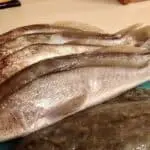Anglers everywhere know that mullet is a popular fish for catching and eating.
Sought after commercially and recreationally, mullet have a very wide distribution, ranging from the North Atlantic to the Caribbean sea and along coastlines in between.
Since there’s a chance that you might find a mullet at the end of your hook, it’s worth knowing how to prepare this fish so that you can enjoy this fruit of the sea.
Table of Contents
- Do Mullet Have A Lot Of Bones?
- Do Red Mullet Have a Lot of Bones?
- Does Grey Mullet Have Bones?
- How Do You Debone A mullet?
- Why Are Mullet fish Boney?
- Can you Eat Mullet Bones?
- Related Posts
Do Mullet Have A Lot Of Bones?
Most species of mullet are considered bony fish, and oftentimes they are cooked whole or butterfly-filleted because cleaning around the bone structure can be difficult. It’s easier and more flavorful to eat the cooked meat directly off the fish.
It’s also recommended that full-size mullet are taken for eating, as specimens that are too small (like finger mullet) may be too bony to eat.
Do Red Mullet Have a Lot of Bones?
Red mullets, or goatfish, are an entirely separate species from the rest of the Mullidae family. However, they are no less bony than the other mullets. Red mullet uses similar fillet techniques as other mullets to remove the flesh with minimal bones embedded.
Does Grey Mullet Have Bones?
As grey mullet is one of the three main mullet species, it is also a bony fish that should be filleted carefully to maximize the meat available relative to bone content.
But did you know that mullet are filled with a delicious roe that is considered a delicacy?
Whatever you do, don’t throw away this prized piece of fish!
How Do You Debone A mullet?

Step 1
Take your fillet knife and place it just behind the gill plate that covers the opening of the gills. With the knife at approximately a 45 degree angle to the dorsal side, or backbone of the fish, slice down until you reach the backbone (it will feel hard).
Step 2
Next, rotate the knife approximately 45 degrees upwards towards the skin of the fish, slide the knife along the backbone until you reach the tail. Slicing through will remove the fillet of the mullet, leaving a small strip of pin bones in the flesh.
Step 3
Repeat on the other side for the other fillet, and if you wish to completely remove the other bones, take your knife or a spoon and run along the strip of bones, pulling them out from the flesh.
Extra Steps
If you are very determined, you can cut away the residual meat that hangs to the backbone, but this is usually minimal compared to the rest of the fillets and better saved for a mullet soup or fishbone stock.
Why Are Mullet fish Boney?
While most fish have the same bone structure as far as the number of bones, bone density can vary between different fish species for a variety of reasons, including habitat, diet, and mobility.
Smaller fish appear to have more bones, though in reality, they have approximately the same quantity of bones as larger fish species.
For smaller mullet, particularly ones that are preyed upon by other species, having smaller, more flexible bones improves mobility in the water, allowing fish to escape possible predation.
Mullet make excellent bait for a variety of larger fish such as sharks and tarpon, as well as turtles and wading birds.
When comparing mullets to other species, such as tuna, mackerel or salmon, they appear to have many more bones though they actually have similar bone structures to these other fish.
Can you Eat Mullet Bones?
Mullet is considered to be a “fishy” fish given its rich concentration of oils.
While some may find its flavor and the presence of bones unappealing, smaller bones are edible, though they should be chewed carefully to avoid choking; in most cases, they can also be easily removed while eating.
Mullet bones can also be used for fish stock.
Using the cleaned fish (no guts, gizzard or gills) with the remaining bones and backbone from filleting, you can simmer these remaining scraps in a pot with different vegetables, such as onion, carrot, and celery, to create a rich broth to flavor other dishes or to make other types of soup.
Depending on how long you cook the bones, and especially if you use a pressure cooker, you can soften the bones so that they are completely edible.
You May Also Like: Should You Bleed Mullet First Before Cooking?

Growing up in Florida, I’ve been surrounded by saltwater my entire life…and I love sharing my passion with others.
To learn more about why I started Saltwater Mecca, visit the ABOUT page.
Thank you for reading this article. Browse around & have some fun!





